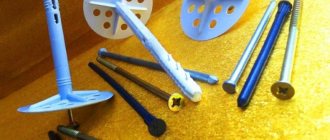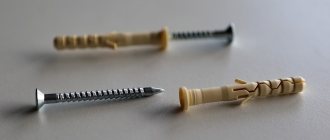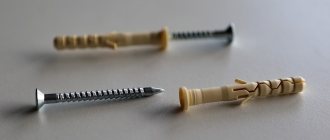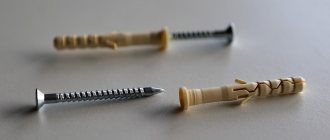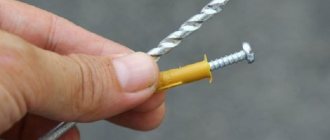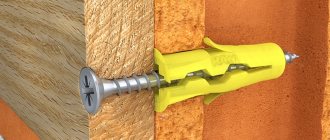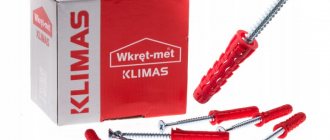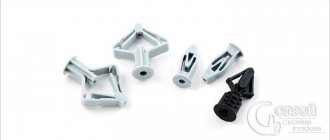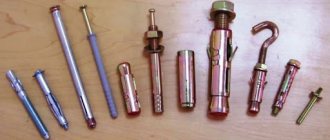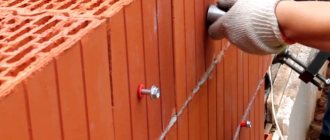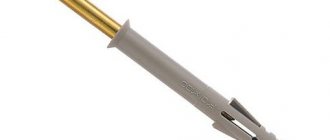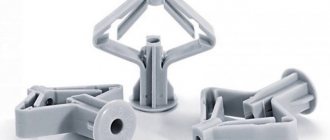All about dowel-nails: size table and fastener weight
Table of contents:
Let's imagine a typical task: you need to fix a heavy shelf for books on the concrete wall of a room. Self-tapping screws cannot be used. It will fall out. In Soviet times, a wooden dowel or, in other words, a chopik was inserted into a drilled hole for sealing. Nowadays a dowel-nail is used as a fastener: dimensions start from 5x30 mm. Here 5 is the diameter of the hole in the sleeve, and 30 is the length of the nail itself.
Typical sizes
Let us present the main characteristics of universal products in the form of a table:
| Type | Dimensions | Installation | Permissible load (brick, concrete) | ||||||
| d | L | t | d | h1 | Nbet. | Vbet. | Nbrick. | Vbrick. | |
| Expandet Nail Anchor | Ext. anchor diameter, mm | Anchor length, mm | Max. thickness of fixing item, mm | Diameter dia. holes, mm | Min. height depth holes, mm | Tensile load, kg | Cross-river load, kg | Tensile load, kg | Cross-river load, kg |
| 5×30 | 5 | 30 | 5 | 5 | 40 | 30,59 | 35,69 | 20,39 | 35,69 |
| 5×40 | 5 | 40 | 15 | 5 | 50 | 30,59 | 35,69 | 20,39 | 35,69 |
| 5×50 | 5 | 50 | 25 | 5 | 60 | 30,59 | 35,69 | 20,39 | 35,69 |
| 6×35 | 6 | 35 | 5 | 6 | 45 | 45,88 | 56,08 | 30,59 | 56,08 |
| 6×40 | 6 | 40 | 10 | 6 | 50 | 45,88 | 56,08 | 30,59 | 56,08 |
| 6×50 | 6 | 50 | 20 | 6 | 60 | 45,88 | 56,08 | 30,59 | 56,08 |
| 6×60 | 6 | 60 | 30 | 6 | 70 | 45,88 | 56,08 | 30,59 | 56,08 |
| 6×70 | 6 | 70 | 40 | 6 | 80 | 45,88 | 35,69 | 30,59 | 35,69 |
| 8×50 | 8 | 50 | 10 | 8 | 60 | 56,08 | 91,77 | 45,88 | 91,77 |
| 8×60 | 8 | 60 | 20 | 8 | 70 | 56,08 | 91,77 | 45,88 | 91,77 |
| 8×80 | 8 | 80 | 40 | 8 | 90 | 56,08 | 91,77 | 45,88 | 91,77 |
| 8×100 | 8 | 100 | 60 | 8 | 110 | 56,08 | 50,98 | 45,88 | 50,98 |
| 8×120 | 8 | 120 | 80 | 8 | 130 | 56,08 | 50,98 | 45,88 | 50,98 |
| 8×140 | 8 | 140 | 100 | 8 | 150 | 56,08 | 50,98 | 45,88 | 50,98 |
| 10×80 | 10 | 80 | 30 | 10 | 90 | 76,47 | 50,98 | 56,08 | 50,98 |
| 10×100 | 10 | 100 | 50 | 10 | 110 | 76,47 | 50,98 | 56,08 | 50,98 |
| 10×120 | 10 | 120 | 70 | 10 | 130 | 76,47 | 50,98 | 56,08 | 50,98 |
| 10×140 | 10 | 140 | 90 | 10 | 150 | 76,47 | 50,98 | 56,08 | 50,98 |
| 10×160 | 10 | 160 | 110 | 10 | 170 | 76,47 | 50,98 | 56,08 | 50,98 |
Table 1.
Here the lateral load is the weight that the dowel can support. This is a force directed vertically. That is, from the center of the edge of the fastener to the ground.
Sometimes it is useful to know how many kilograms there will be in 1000 pieces of fasteners. Especially if there is a lot of work to be done and the size of the warehouse is limited.
| Type | Weight 1000 pcs., kg |
| With polypropylene dowel | |
| 6×40 | 3,3 |
| 6×60 | 4,89 |
| 6×80 | 7,28 |
| 8×60 | 8,5 |
| 8×80 | 11,02 |
| 8×100 | 13,78 |
| 8×120 | 16,53 |
| 8×140 | 19,3 |
| 10×100 | 15,32 |
| Gun nails | |
| 4,5×30 | 5,1 |
| 4,5×40 | 6,45 |
| 4,5×60 | 7,7 |
| 4,5×60 | 8,84 |
table 2.
What is a dowel-nail
A dowel-nail is a metal fastener that is hammered or screwed into a plastic or metal body. The installation process looks like this:
A hole is drilled in the material.
Insert a bushing into the hole.
They hammer a nail inside.
The expansion mechanism expands and the fastener gets stuck in the concrete or brick. This results in a reliable connection. It does not lose its properties for several years.
The service life depends on the type of materials from which the elements are made and on external conditions. High humidity will cause even a galvanized rod to oxidize, and direct rays of the sun will destroy the plastic sleeve.
If the length of the nail does not exceed 50 mm, then its maximum curvature will be 0.1 mm.
We invite you to watch a video about the types and characteristics of dowels:
Dowel-nail 6x40 mm with mushroom-shaped cuff (600 pcs)
If for any reason the goods do not suit you, you can issue a return. Claims and questions about the procedure for returning goods of proper and inadequate quality are regulated in accordance with the provisions of the current legislation of the Russian Federation on the protection of consumer rights.
You can return the goods by mail or to the address: St. Petersburg, st. Magnitogorskaya, 32 (on weekdays from 9 to 18.00).
Transport costs and postage costs are paid by:
- seller (LLC "Trading House "Edelweiss") - if the goods received do not correspond to the characteristics specified in the order;
– buyer – if the goods received fully comply with the quality and contents of the order in the online store.
Return of quality goods
Goods of good quality, but not suitable for any reason, purchased from the Stroybat online store can be returned within 14 days (for buyers from St. Petersburg and the Leningrad region).
When returning goods, the customer can choose:
- other goods for the same amount
— other goods with recalculation if there is a difference in price
— refund of the amount paid for the goods.
Important! Only goods that have not lost their consumer properties, presentation, and also if there is a receipt or other confirmation of payment for the goods can be returned.
Return of low-quality goods
If upon receipt of the order the product is found to be of inadequate quality, it is also subject to exchange and return. A product that has defects, has lost its functional properties and performance characteristics, or has lost its presentation is considered to be of poor quality.
Note! Failure to match the packaging or design of the product with those depicted on the website is not grounds for deeming the product to be of poor quality. All claims to the appearance and packaging of the goods must be recorded upon receipt and verification of the order in a special document drawn up with representatives of the delivery service or transport company.
Claims to the quality of the purchased goods are considered in the manner and within the time limits regulated by the current legislation of the Russian Federation. Refunds are made within 10 days from the date of presentation of the relevant request in the same way as payment was made. If a product is returned of inadequate quality, the customer will be refunded the amount paid for the product and delivery costs. If the order contains items of proper quality, delivery costs are not refundable.
Note!
When paying for an order with a bank card, a refund is made to the card that was used to pay for the order.
If you refuse items from an already paid order or cancel the entire order, you can choose other products for the same amount or return the cost of the order. To do this, you need to submit a request by e-mail
If you have any questions about the procedure for returning goods, you can contact the employees of Edelweiss Trading House LLC by email. We will definitely help solve your problem!
Installation type
There are two ways to install the fastener:
Manual . You will need a hammer drill, screwdriver or hammer. You will have to drill a hole, insert a sleeve into it with your own hands, and then screw or drive in the rod.
Automatic . Installation is carried out using a gun. Use a special nail without a dowel with a strength of 53-56 HRC on the Rockwell scale.
The second option benefits from high installation speed. But the first is good because the standard rod can be pulled out without damaging the material or design.
Features of work
There is nothing complicated about fastening objects with dowels. The work on preparing and using fasteners is as follows:
- Using a drill, you need to drill several holes in the part that you plan to attach to the surface. The heavier this part and the larger its dimensions, the more holes need to be made in it.
- Take a tape measure and a pencil and determine the mounting points on the very surface of the wall. Of course, you also need to make holes in these places using a hammer drill.
- First, plastic elements are installed into the finished holes, and then, after leaning the part against the place of fixation, metal nails are driven in with a hammer or screwed in with a screwdriver.
A 6 by 40 dowel allows you to create a reliable fixation of objects in places where it is difficult to work with a screwdriver. One of the main advantages of such hardware is the speed of installation. Using dowel nails, you can cover the wall with plasterboard sheets or thermal insulation on both the internal and external surfaces of the wall.
Dowel-nail 6x40, technical characteristics
Every set of tools should have dowel-nails; this is an indispensable component in many repair and construction works.
Thanks to the type of nail in question, the installation process becomes efficient, which means that both effort and time are saved during fastening. It should also be noted that dismantling, as well as installation of the dowel-nail, is quite simple, and fastening with such an element is very strong and durable. In order to quickly dismantle this element, you must first carefully unscrew the nail inserted into it from the dowel itself, and only after this procedure can you remove the “cut” of the nail with a regular screwdriver (preferably a Phillips screwdriver).
Among consumers during fastening work, it is common to use a 6x40 mm dowel-nail. The design of the fastening element in question is quite simple, which makes it convenient to use. The price category of this fastener is quite low, so purchasing such a product will not be difficult for anyone. At any point of sale of hardware and fasteners you can find an unlimited number of such nails.
Where is the 6x40 dowel nail used?
The fastening parts in question are used everywhere and are considered universal nails. Their range of applications is quite wide; they can be used to attach various types of structural elements to materials such as stone, various types of brick, reinforced concrete, etc.
Experts do not recommend using dowel-nails for hollow-type materials and porous surfaces. A 6x40 dowel-nail, the technical characteristics of which will be discussed below, is driven in with a hammer, but before that, do not forget about the preliminary preparation of a special hole where the fastener in question will be inserted.
The high demand for the element in question is due to three criteria and, at the same time, the advantages of such a nail, namely: extremely simple design, low cost and practicality. Dowel-nails 6x40 are popular during the installation of support-type structures, because in this process you simply cannot do without them.
What kind of drill for a 6 x 40 dowel?
Additional information: If it is necessary to fasten light objects, it is recommended to use dowels 6 (mm) thick, 40-60 (mm) long with a drill with a diameter of 5-6 (mm). If you need to attach heavy elements, you should use dowels 10 (mm) thick, 60-80 (mm) long with a drill with a diameter of 9-10 (mm).
Interesting materials:
How to get from Domodedovo Airport to Moscow? How to get from Devyatkino to Mega Parnas? How to prove relationship with a grandson? How long does apple wine ferment? How long does Gelish last? How long does a tattoo last on a hand? How long does conjunctivitis last? How long to store cut watermelon? How long does it take to bathe a baby in a diaper? How long can products be used after the expiration date?
Technical characteristics of the fastener
Most construction and finishing works cannot be done without the use of this part. It should also be noted that the dowel-nail is always supplied exclusively as a set, so you don’t have to look for and purchase a separate “frame” for the nail.
We would like to inform you that under no circumstances should screws replace nails; this replacement will be inappropriate, incorrect and impractical. A 6x40 mm dowel-nail, the characteristics of which are its advantages in comparison with similar types of fasteners, can be made of different materials (nylon, polypropylene, polyethylene).
The fastener in question consists of several parts, directly from a dowel (hence the name of this type of nail), double-spacer, on the surface of which there are no tangential fixing elements in the form of ailerons, or, for example, mustaches. The top of the part (later the head) can be of several shapes - cylinder, mushroom-shaped and secretive.
The second element of the 6x40 mm dowel-nail is, directly, a nail in the form of a screw. It is usually made of carbon steel, but this is not the only layer that is used to cover the screw. Among other things, a zinc layer is applied to the surface of the fastening element in question, which serves both for protection and performs a decorative function.
Characteristics of fasteners
The 6x40 dowel is covered with a plastic shell that performs a spacer action. The main rod is made of galvanized steel. The hole for such a fastener is made using a 6 mm drill. After drilling, the sleeve is secured, and then the nail is driven in with an ordinary hammer.
If any other fastener cannot be removed in the future after installation, then the 6x40 nail can be unscrewed using a screwdriver. The diameter of the plastic element of such a dowel is 6 mm, and the length is 4 cm. The nail itself is half a centimeter longer , but its diameter is 2 mm smaller.
A 6 by 40 dowel nail can be screwed into wood, brick or concrete. can be used quickly install and secure various objects .
The main element of such hardware is a cone-shaped metal nail that decreases in diameter downwards. It can be driven into the wall with a hammer. To secure it in the surface, you can also use a screwdriver: it has a special thread for this purpose. If you want to get the job done as quickly as possible, it is better to use a hammer.
Material and coating
Most often, the part is made of various types of plastic (polyamide, polypropylene, etc. In practice, there are also dowels made of metal (rare cases, but they do occur). The nail in the element in question is an alloy of metals, but besides everything else , coated with zinc.
It is worth noting that there is a 6x40 dowel-nail with a thread, and there is one without it, so when choosing the fasteners you need, you should pay attention to this nuance.
Source
The dowel-nail may differ in the type of fastening
A manually installed dowel-nail can be with or without thread; such an element can be easily pulled out of a concrete or brick surface using a screwdriver.
Element for a construction-assembly gun. Such a gun attaches the part to the surface. This type of fastening can withstand significant loads, unlike the manual type. Dowels can be made from various types of plastic; the elements can withstand fasteners of up to 450 kilograms in a concrete surface, and up to 400 kilograms in a brick surface. The elements can be made of steel, and the coating is zinc, they are used for fastening heavy objects.
How to choose a dowel?
Content
What makes a good master? Nothing is too small for him! He also pays great attention to the choice of dowels. And this is no coincidence: an incorrectly selected or low-quality dowel can completely ruin the result of long-term work. Which dowel should I buy? How to choose a drill for a dowel? Let's find out!
Let's see what the wall is made of
Concrete, brick
Spacer dowels will do . There are several varieties of them. The expansion dowel with spikes (often called “Chapai”) has teeth and two spikes. When installed, it expands and fits tightly into the wall. The spikes rest against the wall and prevent the dowel from turning. They are especially important in vertical installations where the load acts downward.
The reinforced expansion dowel (hedgehog dowel) for the concrete screw does not have spikes. But during installation, it expands along its entire length, and the teeth with which its body is covered prevent it from turning. Suitable for heavy loads.
The three-expansion dowel (T-dowel) is also designed for high loads. Often used to secure furniture, shelves and other heavy objects. It has a spacer part - walls with ribs that are securely fixed in the wall, and a non-spacer part - a side that protects against falling into the hole.
From left to right: expansion dowel with spikes, expansion dowel reinforced, three-expansion dowel
Aerated concrete, foam concrete and other porous materials
There are two types of fasteners most commonly used. Due to the large number of these same cutters, the dowel with cutters is firmly fixed in the foam blocks. A dowel with screw ribs is also able to hold securely in such materials: its ribs provide excellent grip.
From left to right: dowel for aerated concrete with cutters, screw dowel for aerated concrete
Drywall and gypsum board
Driva screw dowels are used . With their help, you can secure cable ducts, mount baseboards, light sources, etc.
Another option is butterfly dowels . They are ideal for securing heavier structures - typically up to 16 kg. When installed in a hole, they spread their “wings”, creating the strongest possible connection.
From left to right: Driva dowel, butterfly dowel
Types of dowels
As the fastener penetrates the wall, its plastic element expands and is therefore securely fixed. At one end there is a cuff designed to prevent the fastener from being completely immersed in the wall surface.
The shape of these cuffs can be different, and in this regard, several types of dowels are distinguished:
- "Mushroom Nail" . Its upper part is round. Used when increased downforce is required. Since such a cuff is quite thick, the pressure is distributed evenly, and the attached object is not damaged. After screwing or driving in the “fungus”, its upper part remains outside.
- "Nail-sunk" . It is used if you need to hide the head of a fastener in the wall. The nail head may have a flat surface. In this case, only a hammer is used to fix it in the wall, while the reverse process, that is, pulling out an already fixed nail, is not possible.
However, most often there are recesses on the head , which allow the use of devices such as a screwdriver or screwdriver for screwing. If the dowel was mounted into the wall with their help, then it can be pulled out if necessary. They can be used repeatedly.
Dowels are made from different materials. Metal fasteners are typically used to secure objects to a cement or drywall wall.
Most often they are used on the farm from plastic. If installed in a concrete wall, they can withstand a load of up to 450 kg. If the wall into which they are screwed is brick, then the maximum permissible load will be slightly less than 400 kg.
Fasteners of this type are also divided into several varieties, depending on the type of fastening:
- Dowel designed for manual installation. It usually has a thread. It can be easily unscrewed from the surface using a regular screwdriver.
- A dowel designed for fixation using a construction gun. Such fastening can withstand serious loads. If you need particularly strong fixation, then it is better to use this particular type of dowel-nails.
We take into account what we will attach
Some building materials and structures cannot be fastened with conventional dowels. They require special, highly specialized fasteners, otherwise all the work may go down the drain. Let's look at such examples.
Thermal insulation and waterproofing
The most common option is a mushroom dowel (plate-shaped). Its large head allows you to attach polystyrene, polystyrene and other similar materials as firmly as possible and at the same time accurately.
Selecting a dowel based on material of manufacture
Metal dowels
+ High strength and rigidity
+ High load-bearing capacity
– Loss of properties during deformation
Usually made of galvanized stainless steel. More reliable and durable - made from special alloys with chromium, titanium, etc. They resist corrosion better. However, their cost is quite high, so they are used most often for critical work.
Plastic dowels
+ Not subject to corrosion
+ Do not lose their properties when deformed due to high elasticity
– Cannot be used in fire hazardous areas
– Have less rigidity and load-bearing capacity than metal ones
| Plastic dowel material | Advantages | Flaws |
| Polyethylene | Resistance to acids, deformation and low temperatures | Over time it begins to crack |
| Polypropylene | Heat resistance up to 140 °C, high hardness | Over time it begins to crack. Low resistance to frost |
| Polyamide (nylon) | High strength, rigidity, resistance to vibration and mechanical damage. Considered the most reliable of all materials for plastic dowels | Hygroscopicity, which makes it impossible to work in frost or high humidity |
